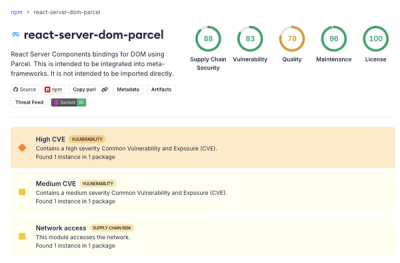@storyblok/app-extension-auth
A JavaScript library for managing authentication for Storyblok apps.
Migrating v1 to v2
The @storyblok/app-extension-auth v1 stored the access token in a cookie. However, in a future version of v2, the library will offer an adapter pattern, allowing you to store the access token elsewhere, such as in a dedicated database. The following breaking changes abstract the code to make this transition easier in the near future:
sessionCookieStore → getSessionStore
import { sessionCookieStore } from '@storyblok/app-extension-auth'
import { getSessionStore } from '@storyblok/app-extension-auth'
getSessionStore
const sessionStore = getSessionStore(authHandlerParams)({
req: event.node.req,
res: event.node.res,
})
The sessionStore created by sessionCookieStore now exposes four methods: get, getAll, put, and remove.
- The
getAll method returns all app sessions, regardless of the spaces that the user has open.
- The
put and remove methods now return a Promise<boolean> instead of a Promise<void>.
AuthHandlerParams
import { authHandler } from '@storyblok/app-extension-auth'
const params: AuthHandlerParams = {
}
authHandler(params)
The parameter AuthHandlerParams['cookieName'] has been renamed to AuthHandlerParams['sessionKey'].
Getting Started
See our starters:
Install the library
Install with:
# npm
npm install @storyblok/app-extension-auth
#yarn
yarn add @storyblok/app-extension-auth
Set a URL
Decide a URL for your app. As a first step, this should be a URL for local development. For this you will need a secure tunnel, for example ngrok.
To open a secure tunnel with ngrok, run:
ngrok http 3000
Set up an App in Storyblok's Partner Portal
Create an App in Storyblok's Partner Portal. Then open app's settings, navigate to Oauth 2, and configure the following values:
-
URL to your app: the index page of your app. For example, https://my-app.com/.
-
OAuth2 callback URL: the api endpoint that will initiate the OAuth flow.
- Calculated as:
{baseUrl}/{endpointPrefix}/storyblok/callback
- Example value:
https://my-app.com/api/connect/storyblok/callback
Substitute {baseUrl} and {endpointPrefix} for your own values. These parameters will be referenced again in your code; see the next section.
Define constants
In your source code, create the following object (you will need it later):
import { AuthHandlerParams } from '@storyblok/app-extension-auth'
export const params: AuthHandlerParams = {
clientId: process.env.APP_CLIENT_ID,
clientSecret: process.env.APP_CLIENT_SECRET,
baseUrl: process.env.APP_URL,
successCallback: '/',
errorCallback: '/401',
endpointPrefix: '/api/connect',
}
Some variables should be loaded via environmental variables (.env.local):
-
clientId -- The client ID is a public identifier for your apps. Find the Client ID in the app settings on Storyblok.
-
clientSecret -- The client secret is a secret known only to the application and the authorization server. Find the client secret in the app settings on Storyblok.
Load it into the application as an environmental variable.
It must be kept confidential.
-
baseUrl -- The base URL specifies the base URL to use for all relative authentication API endpoints created by authHandler().
The base URL must be absolute and secure with https.
For example, the base URL https://my-app.my-domain.com/ will create the following api endpoints:
https://my-app.my-domain.com/storyblok for initiating the authentication flowhttps://my-app.my-domain.com/storyblok/callback as the OAuth2 callback URL
The other variables can be hard-coded:
-
successCallback -- Specifies the URL that the user agent will be redirected to after a successful authentication flow. Defaults to "/".
-
errorCallback -- Specifies the URL that the user agent will be redirected to after an unsuccessful authentication flow. If omitted, the user agent will receive a 401 response without redirect.
-
endpointPrefix -- Specifies the partial URL that is located between the baseUrl and the
authentication API endpoints.
For example, the following two properties
baseUrl: "https://my-app.my-domain.com/"endpointPrefix: "api/authenticate"
will result in the API endpoints
https://my-app.my-domain.com/api/authenticate/storyblok for initiating the authentication flowhttps://my-app.my-domain.com/api/authenticate/storyblok/callback as the OAuth2 callback URL
Create an API route
In NodeJS, create a dynamic route that handles the incoming requests with authHandler(). See Framework examples.
For example, in Next.js, create a file pages/api/connect/[...slugs].ts:
import { authHandler } from '@storyblok/app-extension-auth'
export default authHandler(params)
Sign in
Sign in a user by redirecting to the api route: /api/connect/storyblok
This will initiate the oauth flow and redirect the user to the url specified in the successCallback URL. The following query parameters will be appended to the successCallback URL:
Retrieve the session
Now, use these two query parameters to retrieve the session object:
import { sessionCookieStore } from '@storyblok/app-extension-auth'
const sessionStore = sessionCookieStore(params)(context)
const appSession = await sessionStore.get(query)
if (appSession === undefined) {
}
Use the session
The AppSession object contain user information for personalized content, and an access token to the Storyblok management API.
const { userId, spaceId, region, roles, accessToken } = appSession
Routing
Storyblok apps are embedded within Storyblok via iframes. When a page is requested, the server must get to know
spaceId: the space the page is being embedded withinuserId: the user who loaded the page
These two values needs to be encoded within the page request.
If these two values cannot be retrieved, you need to initiate the OAuth flow by redirecting the user agent to /api/connect/storyblok. After a successful authentication, the spaceId and userId will be added as query parameters to the successCallback value. Now, it should be possible to retrieve the session like so
import { sessionCookieStore } from '@storyblok/app-extension-auth'
const sessionStore = sessionCookieStore(params)(context)
const appSession = await sessionStore.get(query)
When you redirect the user agent to a new page within your application, you need to append the spaceId and userId query parameters. Only if you do this can you retrieve the session from the sessionCookieStore from the other route.
const href = `/my/other/page?spaceId=${spaceId}&userId=${userId}`
How to run this application locally
To run OAuth locally, pass the storyblokApiBaseUrl property to the params object when calling the authHandler function in the target project (i.e. the plugin or application you want to test). With this parameter, you can change the target's backend environment.
import { AuthHandlerParams } from '@storyblok/app-extension-auth'
import { authHandler } from '@storyblok/app-extension-auth'
const params: AuthHandlerParams = {
storyblokApiBaseUrl: 'http://localhost:1234',
}
authHandler(params)
Routing for various frameworks
Next.js
In Next.js, create a file pages/api/connect/[...slugs].ts
import { authHandler } from '@storyblok/app-extension-auth'
export default authHandler(params)
Express
In ExpressJs, create a route
import { authHandler } from '@storyblok/app-extension-auth'
app.all('/api/connect/*', authHandler(params))
Useful Resources



